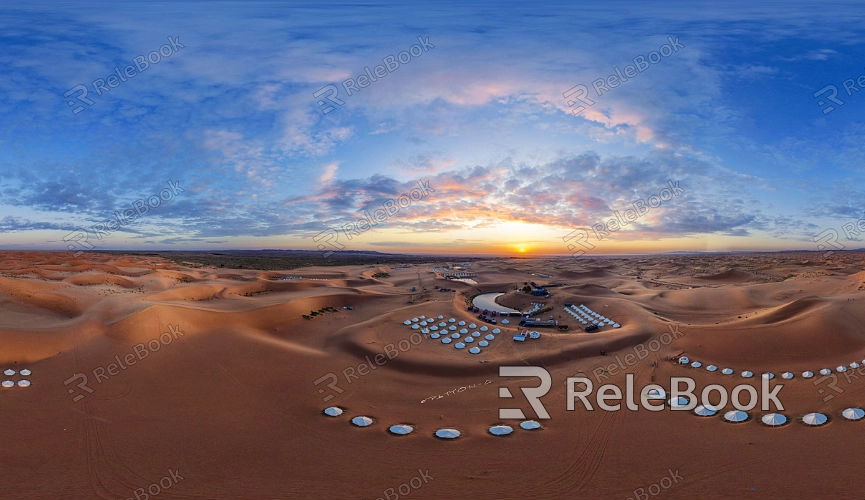What Are HDR Images
HDR images are widely used in 3D software like Blender, 3ds Max, and Cinema 4D because they can capture intricate lighting effects and detailed textures. These images bring a higher level of realism to fields such as architectural visualization, product design, and game development. This article will explore the fundamentals of HDR images, their advantages, common use cases, and practical applications, providing designers with the knowledge to effectively use HDR images to enhance the quality of their work.

1. Understanding the Basics of HDR Images
Before diving into the practical uses of HDR images, it’s essential to grasp their basic concepts.
Definition of High Dynamic Range: HDR images capture and display the full range of light and dark areas in a scene, far exceeding the limitations of traditional images. This ability to retain more details in complex lighting scenarios prevents the loss of information due to overexposure or underexposure.
Difference from LDR Images: Traditional Low Dynamic Range (LDR) images typically show details within a limited brightness range, while HDR images can display all the nuances of a scene across a broader range of brightness levels. This makes HDR images capable of rendering more realistic lighting effects.
2. Applications of HDR Images
HDR images are highly valued across various design fields for their superior detail and lighting capabilities.
Architectural Visualization: In architectural visualization, HDR images can accurately depict lighting variations both indoors and outdoors. Whether capturing the transition from day to night or different weather conditions, HDR images can realistically reproduce these effects.
Product Design: In product design, HDR images enhance the reflective qualities and textures of materials, making surfaces appear more lifelike. This is particularly beneficial when showcasing reflective materials like metal or glass, where the advantages of HDR are most apparent.
Game Development: HDR images are also extensively used in game development, providing more dynamic lighting effects that make virtual environments look more vivid and lifelike.
3. Creating HDR Images
The process of creating HDR images usually involves combining multiple photos with different exposures.
Capturing Multiple Exposures: Designers need to capture several photos with varying exposure levels, typically ranging from the darkest to the brightest details in a scene. These photos provide the complete lighting information needed for the HDR image.
Merging HDR Images: In 3D software like Blender or Photoshop, these differently exposed photos can be merged into a single HDR image. Using compositing tools within the software, designers can control the dynamic range and detail representation in the final image.

4. The Role of HDR Images in Rendering
One of the key uses of HDR images is in 3D rendering, where they serve as environment light sources or reflection maps to enhance the realism of the render.
Environment Lighting: Using an HDR image as an environment light source in a render provides even and natural illumination throughout the scene, closely simulating the way natural light interacts with the environment.
Reflection Maps: Applying an HDR image as a reflection map gives reflective materials in the scene a more authentic environmental reflection, enhancing the texture and depth of objects.
5. Adjusting and Optimizing HDR Images
After creating HDR images, designers often need to make further adjustments to ensure the best results in rendering.
Tone Mapping: Tone mapping compresses the high dynamic range information of an HDR image into the range that display devices can handle. By adjusting tone mapping parameters, designers can preserve important details and contrast in the image.
Brightness and Contrast Adjustments: Depending on the needs of the scene, the brightness and contrast of the HDR image may need to be adjusted during rendering to achieve optimal visual effects.
Detail Enhancement: In some cases, designers may need to enhance the details of an HDR image further, such as through sharpening or noise reduction, to improve clarity and texture.
6. Saving and Exporting HDR Images
The final step after adjusting and optimizing an HDR image is saving it in an appropriate format for future use.
Common HDR Formats: Popular HDR image formats include OpenEXR (.exr) and Radiance (.hdr). These formats retain the full dynamic range data, ensuring no loss of detail in subsequent use.
Optimizing File Size: When saving an HDR image, designers can adjust the resolution and compression settings to balance image quality and file size, making it more suitable for project requirements.
Through this detailed exploration, designers can gain a deeper understanding of HDR images, their applications, and how to create and optimize them. Mastering these skills will help you achieve superior visual effects in your 3D modeling and rendering projects. If you're looking for high-quality HDR images, 3D textures, or model resources, Relebook is an excellent platform to explore. Downloading and integrating these resources can significantly elevate the quality of your projects.

